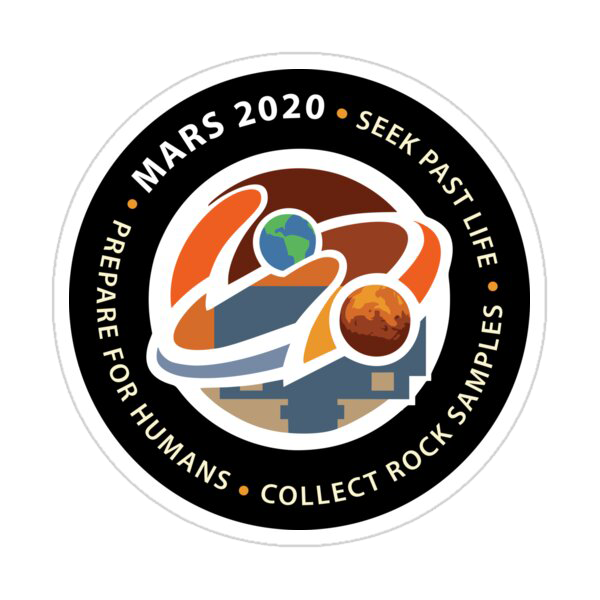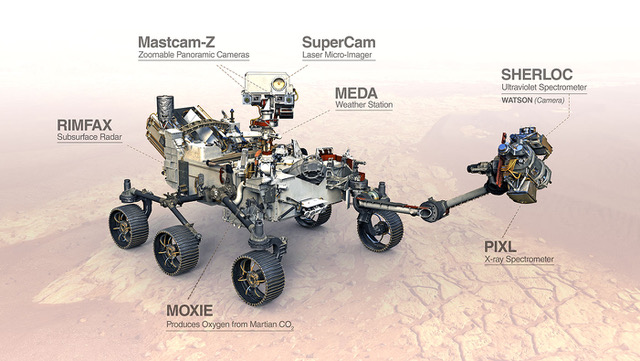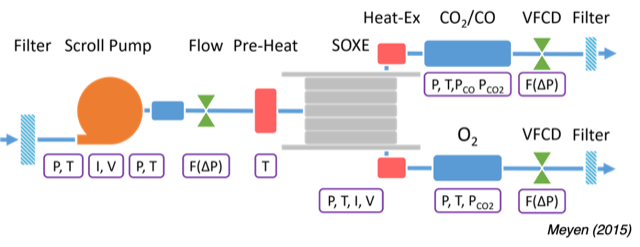- Raise the TRL of the technology by operation in the target environment.
- Inform future design approaches to a full-scale ISRU system based on MOXIE technology.
- To be capable of producing at least 6 g/hr of oxygen in the context of the Mars 2020 mission (assuming atmospheric intake at 5 Torr, typical of Jezero Crater, and 0°C, typical of the rover interior).
- To produce oxygen with > 98% purity.
- To meet these first two requirements for at least 10 operational cycles after delivery. Since MOXIE is expected to operate in all seasons and at all times of day and night on Mars, these requirements are intended to be satisfied under worst-case environmental conditions, including during a dust storm, if possible.
- Demonstrate that MOXIE can meet its development requirements on Mars by operating for 10 cycles while still achieving >6 g/hr oxygen production at >98% purity on the final cycle.
- Demonstrate reliability of MOXIE by consistent operation without significant degradation through at least 10 cycles of operation.
- Demonstrate robustness of MOXIE by producing oxygen near the beginning and end of the primary mission.
- Demonstrate ruggedness of MOXIE by producing oxygen at the extremes of atmospheric density, throughout the full range of atmospheric density, during day and night in all seasons, and during a dust storm if the opportunity presents itself.
- Inform future designs by learning how MOXIE responds to the range of conditions described above.

Feb 22, 2021 (Ls 8.0 MY 36) to [ongoing]

A schematic showing the location of MOXIE and other major instruments. Credit NASA/JPL-Caltec
Experiment Overview
MOXIE is a demonstration of In-Situ Resource Utilization (ISRU) technologies to enable propellant and consumable oxygen production from the Martian atmosphere. This demonstration is a precursor to developing the technology to produce the large mass of cryogenic propellants needed to power an ascent vehicle to transport astronauts from the Mars surface to the orbiting return vehicle.
Goals
Development Requirements
MOXIE development was guided by the following requirements:
These requirements were satisfied prior to delivery, and led to the following success criteria for operation on Mars:
To support a human mission, MOXIE would need to be scaled up about 200 times to autonomously produce at least 24 metric tons (MT) of liquid oxygen (LOX) for ascent vehicle propellant in the 16 months preceding the launch of a human crew to Mars. It is anticipated that this unit would weigh approximately 1 ton and be powered by the same 25-30 kW plant that would support the human mission on arrival of the astronauts.
MOXIE is installed in the belly of a Perseverance, where it is relatively insensitive to external temperatures except for the temperature of the gas intake. The density of the inlet gas, and hence the capacity to produce oxygen, can vary by up to a factor of two over the course of a year and day-night cycles.
As the MOXIE electrolysis subsystem operates at 800° C, an operational cycle consists of a warmup period in excess of 2 hours followed by about 1 hour of actual oxygen production. And This consumes the nominal payload power allocation of ~650 W-hrs for a typical martian sol. These operational cycles allow the team to assess the robustness of MOXIE’s technical performance (flow rate, oxygen production rate, oxygen purity, voltage–current relationship of SOXE), and provide the opportunity to learn how to optimize performance, and to understand how performance changes with environmental conditions and repeated use. Initial plans are to operate MOXIE at least 10 times, distributed over the course of one martian year, with additional runs scheduled as resources allow to achieve explicit experimental objective.

This functional block diagram illustrates the MOXIE process. The CO2 Acquisition and Compression (CAC) system pulls Martian atmosphere, which consists of 95% CO2 and trace gases, from outside the Rover through a filter, with a scroll compressor, compressing it to between 0.5 and 1 bar. The pressurized gas is then heated and fed to the Solid Oxide Electrolyzer (SOXE), operating at 800°C, where the CO2 molecules are catalytically split into O2 and CO, and the O2 is extracted through a zirconia-based electrolysis membrane. The O2 is analyzed for purity before being vented back out to the Mars atmosphere. The CO, unused CO2, and inert gases from the martian atmosphere are also characterized and exhausted through a separate vent. The cooled exhausts are filtered to satisfy planetary protection requirements before venting.
Using a control loop that relates measured current to applied voltage and established relationships between CO2 input flow rate, SOXE temperature, and applied voltage, O2 production is optimized for the under current Mars environmental conditions by means of parameters specified in four command tables. The cooled exhausts are then filtered to satisfy planetary protection requirements and vented from the Rover. Process telemetry is reported to the Rover for downlink.
Background Publications
Farley, K.A., Williford, K.H., Stack, K.M. et al. Mars 2020 Mission Overview. Space Sci Rev 216, 142 (2020). https://doi.org/10.1007/s11214-020-00762-y
Balaram, J., Aung, M. & Golombek, M.P. The Ingenuity Helicopter on the Perseverance Rover. Space Sci Rev 217, 56 (2021). https://doi.org/10.1007/s11214-021-00815-w
MOXIE Documents
Summary Article - Hecht, M., Hoffman, J., Rapp, D. et al. Mars Oxygen ISRU Experiment (MOXIE). Space Sci Rev 217, 9 (2021). https://doi.org/10.1007/s11214-020-00782-8
Documentation
Introduction
Software Interface Specification document (SIS)
Archive Products
Data from other instruments and rover
During a MOXIE run, data from three other instruments are recorded: the Environmental Dynamics Analyzer (MEDA), SuperCam, and Entry, Descent and Landing camera (EDLcam). In addition, several rover parameters are relevant to MOXIE operation, for example, Rover Avionics Mounting Panel (RAMP) temperature. MEDA records atmospheric pressure, surface temperature, relative humidity, upward and downward radiative fluxes in several solar and infrared bands, and atmospheric temperature, wind speed, and 3D wind direction at ~1.5 m, at 1 Hz. During MOXIE runs, MEDA will record a subset of the above (atmospheric pressure, temperature, optical depth, wind speed, and 3D wind direction at ~1.5 m, at 1 Hz) from 3 minutes before the start of oxygen production until 3 minutes after the end of oxygen production. In addition, MEDA’s Radiation and Dust Sensor-Skycam (RDS)-Skycam is also scheduled to acquire two images of the sky each sol to retrieve optical depth, a measure of atmospheric column dust content.The SuperCam and EDLcam microphones are intended to record audio from one minute before to five minutes after the start of scroll compressor operation; from one minute before to two minutes after any change in scroll compressor RPM commanded via the RCT; and from one minute before to one minute after the end of scroll compressor operation.
Data product description
Bundle
Each MOXIE run is stored in a separate directory identified by martian day (sol), beginning on sol 60 (April 20,2021). A run lasts around 3.5 hours: 2.5 hours of warmup followed by 1 hour of oxygen production. See SIS Quick Start Guide for accessing data.
Each data file (raw, calibrated and derived) is stored as a CSV file and contains time series of parameters sampled at 1 Hz.
Raw Data
contains the original data from the instrument in Digital Numbers (DNs).
Calibrated Data
contains the data converted to physical calibrated Units (CUs).
Derived Data
contains data derived from one or more calibrated or derived quantities, for example oxygen mass production rate in g/hr.
1) Downloading an index, selecting components
Indices that tabulate information associated with each product are available.
Calibrated Index (csv)
Derived Index (csv)
Raw Index (csv)
c. Upload the URN values from your revised index (note the total uncompressed file size before requesting)
Indices that tabulate information associated with each product are available.
Calibrated Index (csv)
Derived Index (csv)
Raw Index (csv)
a. Select your index
b. Sort and make your selection
b. Sort and make your selection
c. Upload the URN values from your revised index (note the total uncompressed file size before requesting)
2) Downloading individual files from the directories by clicking on the files.
Downloading annual collections of data
| MOXIE BUNDLE (46.7 MB) |
Citing datasets for publication
M. Hecht (2021), Mars Oxygen In-Situ Resource Utilization Experiment (MOXIE), NASA Planetary Data System, DOI XXXXXX.
Spice
Archived SPICE ancillary data providing observation geometry (positions, orientations, instrument pointing, time conversions, etc.) are available from the PDS NAIF Node.
 PDS: The Planetary Atmospheres Node
PDS: The Planetary Atmospheres Node

